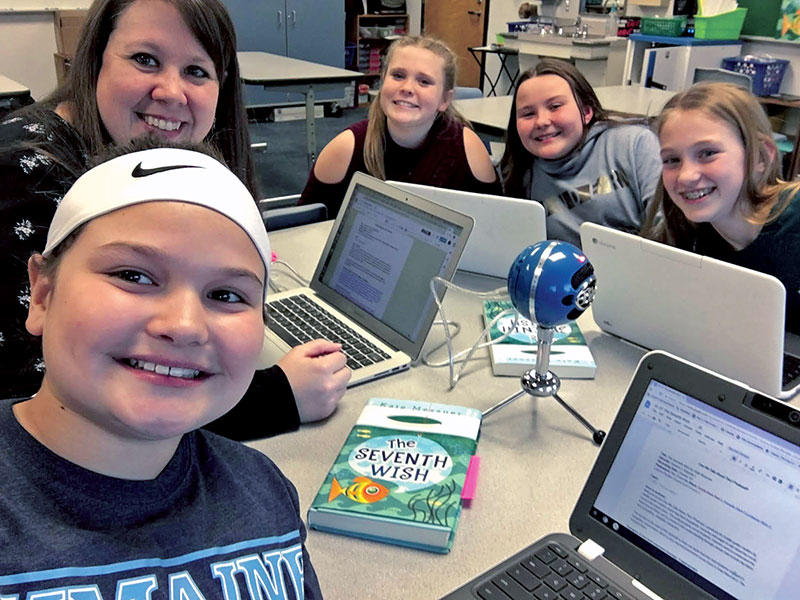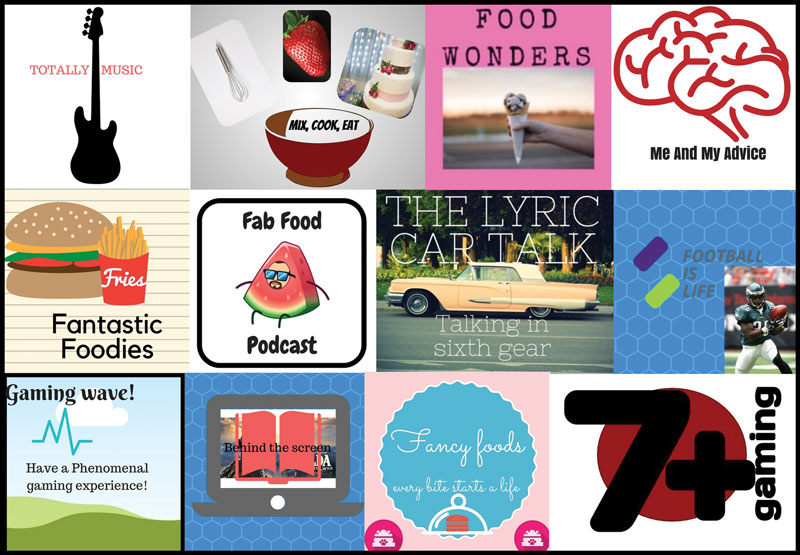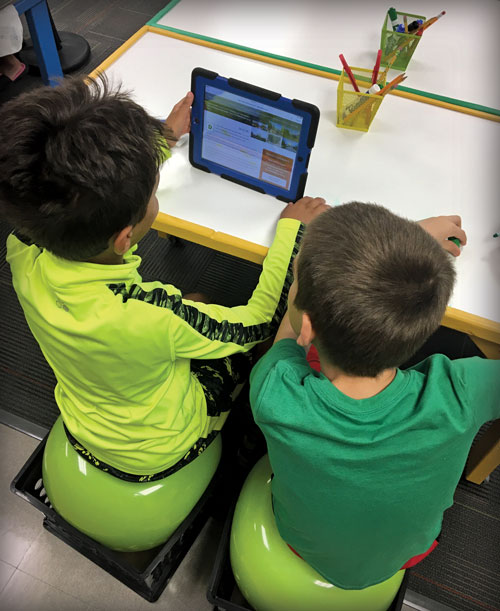Kids Get Real on Podcasts, With Straight Talk on Topics from Proms to Gun Safety
Podcasts offer students a chance to own the conversation—and sometimes spark discussions about subjects adults won’t address. Plus, educators' tech tips and best practices.
 |
Teacher Melissa Guerrette (top left) with sixth-grade podcasters at Oxford Elementary School.Photo courtesy of Oxford Elementary School. |
Three students podcasters are reporting on the tradition of the school prom, and they’re talking dress codes, debutantes, and rules against same-sex couples. “Some schools still have anti-gay bans in place,” one says.
“That’s awful. I hate that, with a passion,” her fellow podcaster chimes in.
“Yeah, it’s kind of dumb.”
“It’s pretty sad.”
The reporters from the half-hour Labetta Encore podcast go on to swiftly condemn anti-gay bias more generally at school-sponsored events. The podcast is part of Kimberly Hawks’s newspaper class at Labette County High School in Altamont, KS. They created it using an app called TunesToTube and uploaded it as an audio file to YouTube, all for free.
In their take on the prom phenom, complete with bloopers and giggles, juniors and seniors Grace, Abby, and Mary also agree that costs for prom are far too high. At a school where more than 50 percent of the students are economically disadvantaged, one host’s brother “was mad because he spent so much money—and was so underwhelmed with what prom actually was.”
Sharing ideas about everything
In other schools around the country, student podcasters are sharing their insights on everything from best middle-grade books to gun violence in schools with any member of the wider public willing to click and listen. The tech they use varies—from free apps such as Audacity, Synth, Anchor, or YouTube, to hardware investments in microphones and mixers—but the process and impact is similar. For a generation used to self-expression on social media and self-guided learning in school, podcasts are a natural medium. They offer students, from elementary to high school, a chance to own the conversation—and sometimes spark discussions about subjects adults won’t address.
Podcasts prompt students to conduct rich research and interviews, formulate strong opinions, communicate through spoken word, experiment with music and apps, and share ideas broadly. “It’s a way for students to be able to create and demonstrate learning,” says Matt Miller, a former middle school teacher in Indiana who consults and writes about tech in the classroom. Students can reach “a bigger audience, rather than just turning something in to a teacher,” he adds. New students in Hawks’s journalism class come in specifically wanting to podcast. “I’ll allow them to communicate to the student body however they are most comfortable,” she says.
Cost barriers have mostly disappeared, with free apps and easy editing on mobile phones. “The technology is very accessible and student-friendly,” says Laura Winnick, middle school librarian at the Blue School in New York City and a coauthor of podcasting lesson plans for the New York Times. “All you need is a phone in terms of recording device and the free audio software.”
Making a podcast can take considerable time, but teachers and librarians balance both scaffolded plans and a DIY approach, where young makers learn the process as they go. Traditional news outlets are eager for students to get on board, as well: the New York Times held its first student podcast contest last year, and the 10 winners included Steel City Academy students’ entry, on their hometown, Gary, IN. In late 2018, NPR launched its inaugural student podcast challenge, with the two winners announced May 1. Bronx middle schoolers tackled the stigma around discussing menstruation, and Elizabethton, TN, high school students investigated a bizarre but true 1916 tale of a hanged circus elephant.
 |
Logos from podcasts by students in the Iowa City School DistrictPhoto courtesy of Andrew Fenstermaker\Iowa City School District |
Taking on big topics
At the Oxford (ME) Elementary School, four sixth graders recently launched a book-related podcast, Can We Talk About This? on Anchor with their fifth-grade teacher, Melissa Guerrette. Podcasting is a way not only for them to share their love of books but also to deepen their own understanding of the characters and subjects they take on.
During the recording of the podcast conversations, which touch on drug use and characters experiencing homelessness in books such as Kate Messner’sThe Seventh Wish and Ann Braden’s The Benefits of Being an Octopus, the students draft and work from scripts—and veer off them freely.
“I’ve grown as a reader more than I would just having a simple basic group discussion,” says student Cecile. Her co-podcaster Natalie adds, “It kind of started because we wanted to learn more about the things that were happening in our community—big topics—that the books have in them, such as drugs or alcohol or disease or racism.”
“The podcast is giving them the opportunity to really explore the issues,” says Guerrette. “They embrace the mission of sharing their discussions in hope that other middle-grade readers will feel inspired and have conversations.”
The students at the school, where nearly 70 percent of students are low-income, were motivated to start the podcast in part because they heard that some adults felt the books dealt with issues that were too mature. “They are hopeful, too, that the grown-ups around them will recognize that they are curious and prepared to have conversations about topics that sometimes seem too big or uncomfortable for kids their age,” adds Guerrette. The teacher runs the podcast as an extracurricular at the school for now, to explore the format and encourage students to gravitate to it as something special.
At Komarek School in North Riverside, IL, creating a podcast tends to get near-universal class participation as varied interests and talents are let loose. Library media specialist Karen Doyle started working with fifth graders this year. A class that tended to be high-energy and off-topic was transformed. “Once we started getting into it, they would get in their groups right away and start writing,” says Doyle. One group focused on the viral kids’ hit song “Baby Shark,” while another told a scary story; a third used dry humor to analyze the phenomenon of fighting kangaroos. “Kids tend to find their voice,” says Doyle.
“Their personalities come through,” says librarian Ali Schilpp, middle school media specialist at Northern Middle School in Accident, MD. The kids can go into a corner of the media center and record themselves talking about the most awesome animal or a recent author visit. Schilpp, SLJ’s 2018 School Librarian of the Year, uses the Google Classroom-connected shared video app Flipgrid, and says that all her students get involved.
Andrew Fenstermaker, instructional technology coordinator and an instructional design strategist for the Iowa City School District, likes to work with Flipgrid because of its simplicity and accessibility. Since he found that using video was too distracting for students, Fenstermaker has students upload logos rather than record themselves. Last year, his fifth graders decided on themes, from school sports and March Madness to fashion and trends such as bottle flipping; a podcast purpose, such as persuasion, informational, or tutorial; and designed titles, logos, and jingles. His students produced serialized podcasts representative of the fixations of 10-year-olds, ranging from The Lyric Car Talk, in which a student interviews fellow car obsessives, to Fantastic Foodies, where two young men offer hot takes on their favorite foods.
 |
Iowa City students work together on a podcastCourtesy of Andrew Fenstermaker\Iowa City School District |
Materializing the voice
For students who find it intimidating to record themselves via video or present in person, podcasting can offer a sense of intimacy, similar to speaking to a friend—who happens to be your entire class (if the class is pushing the podcast to Google Classroom or Flipgrid) or potentially anyone online (if working with a broader commercial app such as Anchor, which helps put podcasts on Spotify or Apple Podcasts). It also draws on this generation’s particular affinity for sharing their musings on social media.
“It materializes the voice,” says Winnick. “We talk a lot about voice disembodied when it comes to writing. It actually is your voice that you are recording—everyone loves their voice—there is something compelling there.” “The audio allows the end user a more open-ended creative idea of who that speaker is,” adds Fenstermaker. “[It] removes some of those potential stressors or anxiety producers [of video] from a student perspective.”
While Fenstermaker’s students pursued their own interests and produced multiple episodes on each one, Winnick’s former high school students in Oakland created an immersive, deeply researched, multi-episode podcast on a single striking event in their city: the 2016 Ghost Ship fire, which killed 36 artists illegally living in a loft-warehouse. Student groups took varied angles on the tragedy, interviewing engineers, housing experts, and artists in the area.
The podcast project they created together was, in part, a solution to the problem of “bored” high school seniors who did not want to write another paper, says Winnick. At the same time, a podcast “demands research, and there are writing skills embedded it in. You have to go out in the world—most have been interview heavy.” Students can take on different roles, from writer to sound engineer.
For at least one student, in Fort Worth, TX, podcasting was a route to a college scholarship. Librarians Nicole Graham and Jenny Stafford, who podcast themselves as Bibliodames, help classes at Paschal High School develop long-form podcast projects, ranging from research on the Gilded Age to personal narratives. In the fall of 2017, a student approached them wanting to create a sports radio show. Without an AV club or sufficient hardware, Graham and Stafford suggested a podcast instead.
“He ran with it,” says Stafford, and sent the recordings in with his college applications. This year, the student received a scholarship to University of North Texas for sports broadcasting.
With a wealth of podcast models for students to emulate, Stafford adds, making their own “builds a passion that they might not know about.”
Tips: getting ready to podcast with students
-
Look at youth-oriented models such as NPR’s Radio Rookies or Hidden Brain and take note of the features in each (music, interview, outside sounds, reporter’s voice, and form). How are these integrated?
-
Connect podcasts to curriculum or a focused prompt, offering starter stems and script guidance if necessary. Ali Schilpp’s students created podcasts about their favorite animals, for instance, after reading The Benefits of Being an Octopus.
-
At the same time, allow wide student choice in topic. Spend time brainstorming ideas and connecting them to narratives and interview choices.
-
Less is more. Setting podcast time limits can help make a better end product.
-
Practice with one-minute classroom interviews before going “into the field” to interview peers, staff, or outside experts.
-
Decide how public you and your students want your podcast to be.
Tech & tools best practices
-
Record sound via mobile devices on voice memos or audio recorder app.
-
Upload and edit on Audacity, Anchor, Podbean, or GarageBand (on computer). Publish via Anchor, Soundcloud, Spotify, or YouTube, with a logo as placeholder image.
-
Consider acquiring a good mic for “studio” (i.e. classroom) recordings such as the Snowball.
-
On classroom computers or Chromebooks, consider Google suite applications that can be used with a sound-only setting, such as Flipgrid.
-
For practitioner tips and slideshows, also check out Matt Miller's ditchthattextbook.com, bibilodames.com, Andrew Fenstermaker's site, and Laura Winnick's contribution to the New York Times podcast plans.
Carly Berwick is a New Jersey-based journalist and high school teacher who is trying her first student podcast projects this spring.
RELATED
The job outlook in 2030: Librarians will be in demand
The job outlook in 2030: Librarians will be in demand
ALREADY A SUBSCRIBER? LOG IN
We are currently offering this content for free. Sign up now to activate your personal profile, where you can save articles for future viewing






Add Comment :-
Comment Policy:
Comment should not be empty !!!